STOLPERSTEINE GELSENKIRCHEN
Ausgrenzung erinnern

← Back
|
HERE LIVED
 SIMON NEUDORF SIMON NEUDORF
BORN 1899
ARRESTED 1938
MURDERED 1941
IN SACHSENHAUSEN
|
|
HERE LIVED
 HERMANN NEUDORF HERMANN NEUDORF
BORN 1925
DISPLACED 1938
BENTSCHEN
1942 RIGA
1944 STUTTHOF
1945 BUCHENWALD
DEATHMARCH BUCHENWALD
RESCUED / SURVIVED
|
HERE LIVED
 FRIEDA NEUDORF FRIEDA NEUDORF
NÉE GRÜNEWALD
BORN 1894
DEPORTED 1942
MURDERED 1944 IN RIGA
|
Stumbling Stones installed at: Markenstraße 19, Gelsenkirchen
The installation of the Stolperstein for Hermann Neudorf took place on 8th October, 2012, whereas the Stolpersteine for his parents Simon and Frieda Neudorf were already installed on 13th July, 2009 – the first Stolpersteine to be installed in Gelsenkirchen.
|
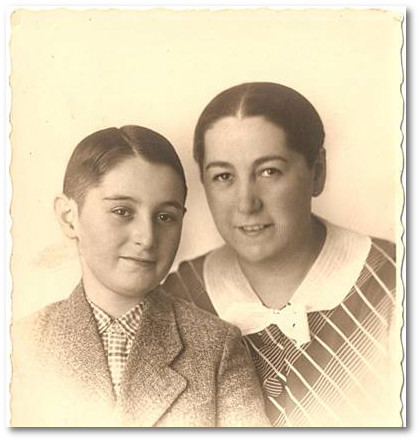
Hermann Neudorf was born on 3rd June, 1925 in the rural community of Horst-Emscher as the only child of Simon Arie and Frieda Neudorf, née Grünewald. On 28th October, 1938 the Nazis got him out of his school class and expelled mother and son to Poland (so-called „Polen-Aktion“). At that time Hermann went to the „Realprogymnasium“ (highschool focussing on natural sciences); which today is the „Gesamtschule“ (comprehensive school) in Horst.
In his diary Herman Neudorf writes „On 28th October, 1938, at an age of merely 13 years, the Gestapo fetched me out of my school class and put into the local jail of Gelsenkirchen. It was there that I met my mother. The two of us were sent to Poland. We had nothing to take with us – my mother had been arrested on her way to the local market – she just carried her handbag with her. My father had been informed that they would arrest only males, he had received a corresponing phone call from Essen. He had been told that they would only arrest the polish-jewish men, but they would leave all women behind. So he went to the Polish Consulate in Düsseldorf, in order to procure necessary documents. As Gestapo did not find him, we were arrested instead. When he finally came back, we had been transported to the German-Polish border.
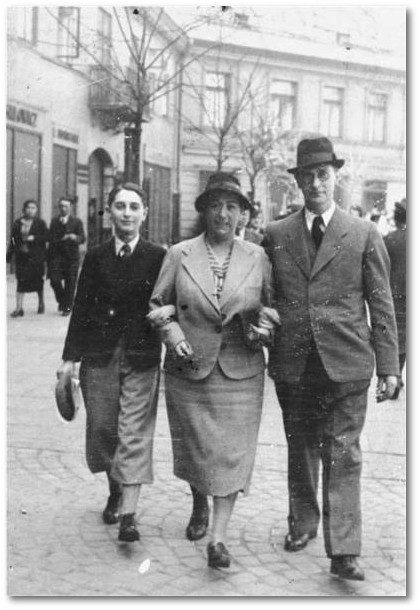
Fig.: Hermann and his parents Simon and Frieda Neudorf in Lodz, approx. In April/May 1939
The Germans had thrown us out – the Polish would not let us in. It was end of October, it was cold, and we had nothing – no blankets, no coats – literally nothing. We camped in schools, lay on thatches of straw, and there was nothing – except a telephone. Thus we could at least call our relatives in Poland, i.e. our grandfather, grandmother and aunts. We could tell them where we were. They sent us some money so we could take the train to them, and they gave us shelter. We were able to contact my father and end of the year, he came to visit us in Poland. His mother had died a natural death in the meantime. We attended the funeral and were together again as a family. Then my father got the permission to return to Germany together with my mother in order to hand his shop over to a new owner, following „Kristallnacht“ and its aftermaths. This must have been in February, 1939. There was not much to hand over, though, everything had been destroyed.
So he went back in order to liquidate his business, and we were under the impression that we could emigrate. The problem in connection with an emigration, above all to the States, was that we were part of the Polish quota, and this Polish quota did not permit us to immigrate into the States before 1943/44. We would have gone ANYWHERE, but it was absolutely impossible, hence why we had no chance whatsoever to escape. There was no place to go to.
On 1st September, war broke out. I was in Lodz, my father and my mother were in Germany. On 2nd or 3rd Sepber my father was arrested as a“ hostile foreign person“.They took him to the concentration camp of Sachsenhausen, adjacent to Berlin. By consequence, my mother was alone in Germany, and I was alone in Lodz. As far as I remember, the Germans invaded Lodz on 8th September. Starting from that very day, everything changed dramatically. Jews were unprotected game. They were seized and loaded on trucks, from one hour to the other jewish people did not know anything about the fate of their husbands, fathers and sons – jews were beaten up or exiled.
Some polish people were happy to get the jobs of the jews. Jews could be treated as one thought best. But this was only the beginning.
In Poland Hermann could find accommodation in some relatives' house in Lodz, after a short time in an internment camp in Bentschen (Zbsaszvn). He luckily could escape from the ghetto of Lodz (Litzmannstadt). On 24th June , 1940 he can initially return to Gelsenkirchen. On 27th January, 1942 Both, Hermann and his mother, were deported from Gelsenkirchen to the Ghetto of Riga. His mother Frieda Neudorf was shot on 28th of July, 1944 when the concentration camp of Kaiserwald was closed and left by the Nazis.
|
|
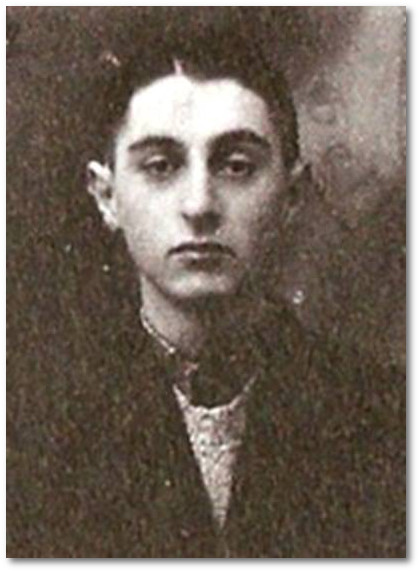
In the months and years of suffering to follow, Hermann's ordeal took him to the concentration camp of Kaiserwald in Riga, from there via the concentration camp of Stutthof to the outer concentration camp of Buchenwald as a forced labourer for the Bochumer Verein and finally back to Buchenwald. On one of the deathmarches Hermann was rescued by American soldiers on 13th April, 1945. Today he lives in the States under the name of Herman Neudorf.
Based on the installation of the „Stolperstein“ for Hermann Neudorf there is an exhibiton the motto of which is a quotation of Hermann Neudorf:“ You have to forgive, but it is impossible to forget.“ The exhibition can be visited from 26th October to 9th November, 2012 and is presented by the Gelsen- zentrum e.V. in cooperation with Mr. Hermann Neudorf in the Gesamtschule Horst (comprehensive school, Gelsenkirchen-Horst).
Teachers and pupils of the 10th, 12th and 13th form of the school are deloping a supportive and multifaceted programme: Besides the presentation of musical performances the participants are planning theatre scenes relating to and reflecting Neudorf's life called „the end of childhood“; an artistic installation under the motto: paths of remembrance as well as further presentations regarding the handling of and dealing with the Nazi aera and the culture of remembrance.
There will be students who are happy to guide you through the exhibition. Citizens are more than welcome to visit the exhibition. Please make your advance booking.Please call the school secretariat of the comprehensive school 0049 209 4503012. Opening and closing ceremony can be attended without any prior booking. The exhibition online: The story of the Neudorf family
|
|
In 1945, Hermann Neudorf put down his ordeal in writing:
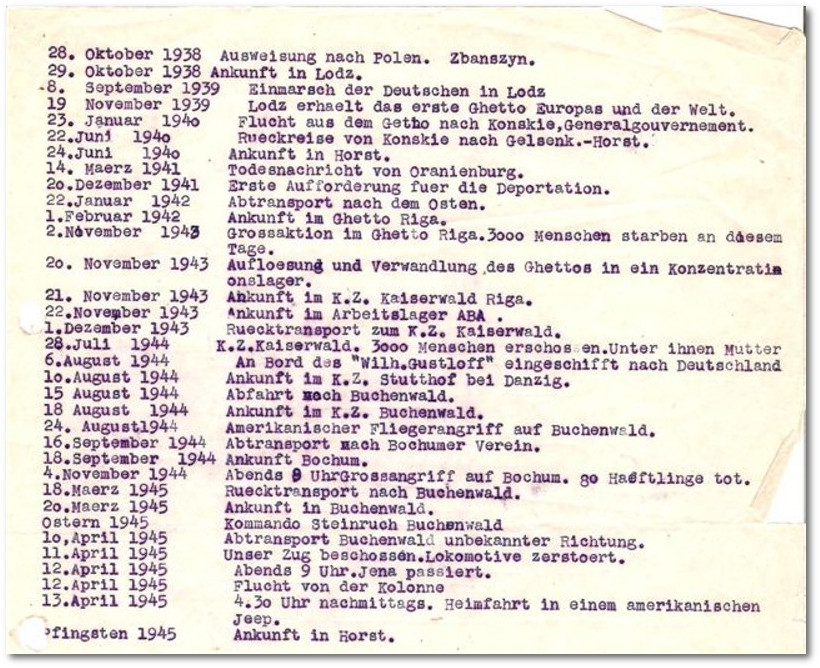
| 28th October, 1938 |
displacement to Poland. Zbanszyn |
| 29th October, 1938 |
arrival in Lodz |
| 08th September, 1939 |
marching in of the German army in Lodz |
| 19th November, 1939 |
Lodz gets the first ghetto in Europe and worldwide |
| 23rd January, 1940 |
escape from the ghetto to Konski, General government |
| 22nd January, 1940 |
back journey from Konskie to Gelsenkirchen-Horst |
| 24th June, 1940 |
arrival in Horst |
| 14th March, 1941 |
news of death from Oranienburg |
| 20th December, 1941 |
first demand to prepare for deportation |
| 22nd January, 1942 |
Transport to the East |
| 01st February, 1942 |
arrival in the ghetto of Riga |
| 02nd November, 1943 |
„Major action“ in the ghetto of Riga. 3,000 people died that day |
| 20th November, 1943 |
liquidation of the ghetto and transformation into a concentration camp |
| 21st November, 1943 |
arrival in the concentration camp Kaiserwald, Riga |
| 22nd November, 1943 |
arrival in labour camp ABA |
| 01st December, 1943 |
transport back to concentration camp Kaiserwald |
| 28th July, 1944 |
3,000 people shot, among them my mother |
| 06th August, 1944 |
embarked for Germany on the „Wilh. Gustloff“ |
| 10th August, 1944 |
arrival in concentration camp Stutthoff near Danzig |
| 15th August, 1944 |
departure to Buchenwald |
| 18th August, 1944 |
arrival in the concentration camp of Buchenwald |
| 24th August, 1944 |
air attack of the American forces of Buchenwald |
| 16th September, 1944 |
transport to Bochum |
| 18th September, 1944 |
arrival in Bochum |
| 04th November 1944 |
major military attack of Bochum 09. p.m., 80 prisoners died |
| 18th March, 1945 |
transport back to Buchenwald |
| 20th March, 1945 |
arrival in Buchenwald |
| Easter 1945 |
command stone quarry in Buchenwald |
| 10th April, 1945 |
transport from Buchenwald – direction unknown |
| 11th April, 1945 |
our train being shot, locomotive destroyed |
| 11th April, 1945 |
our train being shot, locomotive destroyed |
| 12th April, 1945 |
passed Jena at 9 p.m. |
| 12th April, 1945 |
escape from the gang of prisoners |
| 13th April, 1945 |
4.30 h p.m.going homewards in an American jeep |
| Whitsuntide 1945 |
arrival in Gelsenkirchen-Horst |
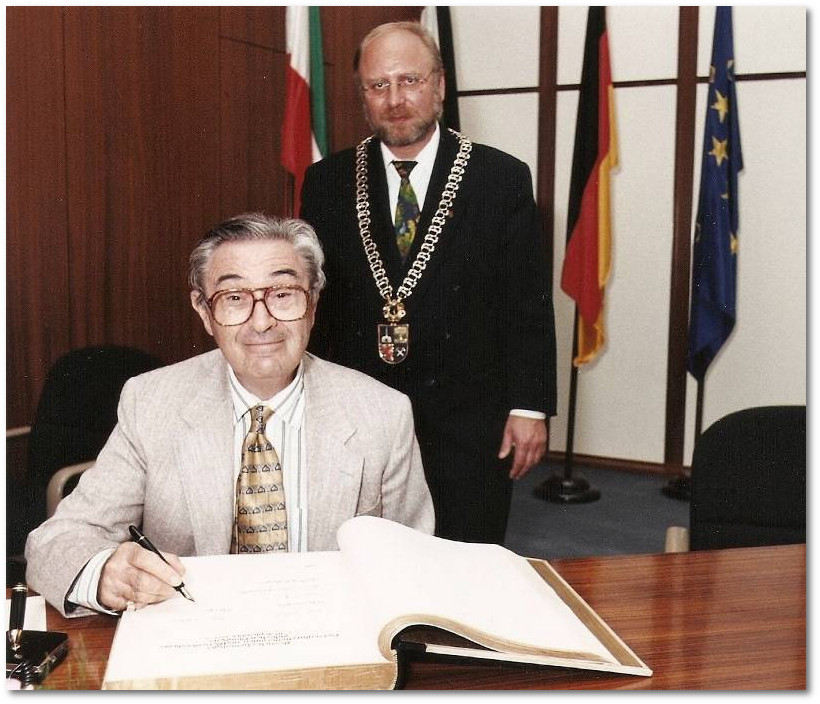
Fig.: Herman Neudorf signs the Golden Book of the city of Gelsenkirchen
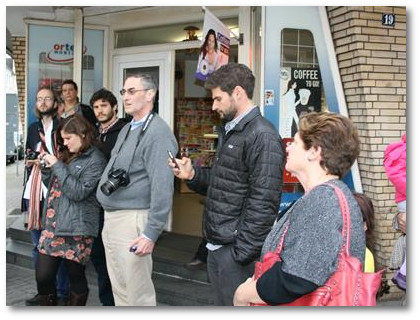
Fig.: Steven Neudorf family at Markenstraße 19
On the occasion of the installation of the Stolperstein for Hermann Neudorf on 08th Octobre, 2012 his eldest son Steven travelled all the way from the States to Gelsenkirchen, together with his wife Nancy and their kids. When the memorial stone was installed, Steven Neudorf called out the following speech in memory of the Neudorf family, which was translated into German by his wife.
"Good afternoon! I am Steven Neudorf and this is my family - my wife Nancy, sons Jack and Danny and my daughter, Emily. My father, Herman grew up on this street and his parents owned a store located at 19 Markenstrasse. My father sends his regards and regrets that he cannot be here today due to health reasons. On behalf of my father and my brothers Howard and Leslie and their families, I would like to thank Andreas and Heike Jordan along with the rest of the organizers of the Stolpersteine program for today’s event. We are fortunate and honored to be here today. We are fortunate because my father was one of the few from Horst who survived. We are also fortunate and thankful that my parents were able to come to America, distance themselves from the horrors of their youth and create a warm, nurturing life for us and our children. And yet the experience of what happened to them and their families never went away. My parents found comfort among other survivors where no explanations were necessary. Many survivors, like my mother Bella, tried to suppress those memories by refusing to talk about her experience. In my mother’s case, those memories resurfaced as she deteriorated from the dementia of Alzheimers. At a time when she could barely communicate with us, she began having nightmares about the Holocaust requiring additional medications to help her be at peace.
When I was a child, I wondered why didn’t we have grandparents? As I got older and my parents explained the Holocaust to us, I became angry with Germany and its people for taking away a part of growing up that most others still look back upon with fondness. Today, that anger is gone thanks in part to efforts by the Stolpersteine program to honor and respect the memory of its citizens and what happened to them.
We are honored to be among the citizens of Horst as we memorialize its former citizens. We are honored to be among a German community that has shown remarkable courage to acknowledge what their ancestors had perpetrated barely one generation ago. In contrast, it took the US more than 100 years after Lincoln outlawed slavery to have to pass a law that officially granted civil rights to all Americans. Sixty years ago we would not be gathering as we are today because we are Jewish. Today we are fortunate and privileged to live in a society that places a high value on personal and religious freedom. It is my hope that the constant reminders etched into these stones will help make
sure that we and all of our descendants never forget what happened here."
This year's installation of Stolpersteine in Gelsenkirchen was duly highlighted by an impressive matinée in Schloss Horst (château of the city of Horst). Many of the guests took the opportunity to sign the visitor's book of Schloss Horst after the ceremony.
|
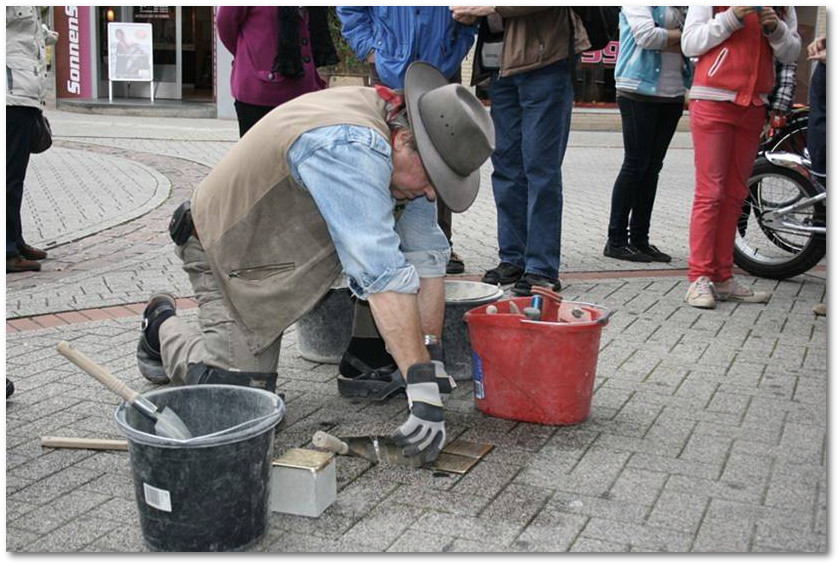
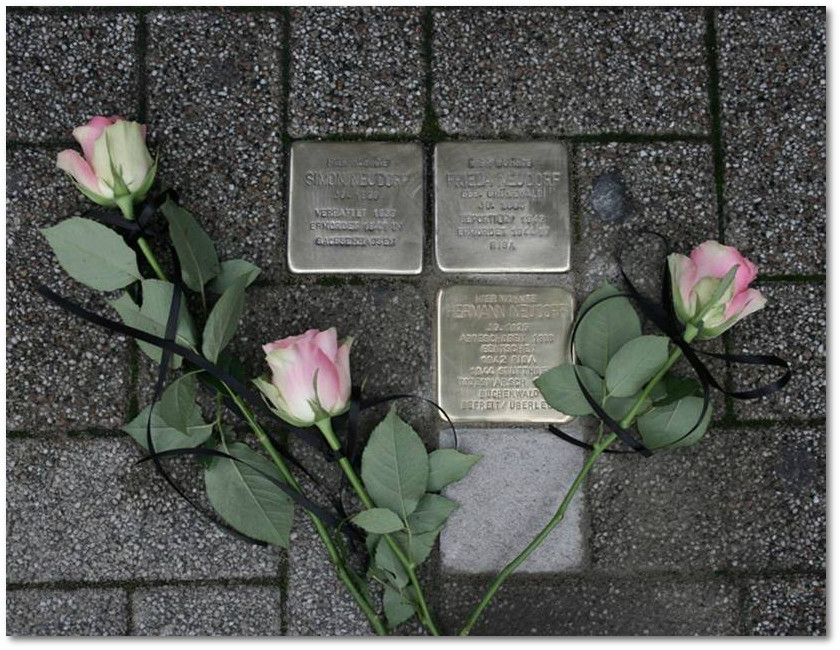
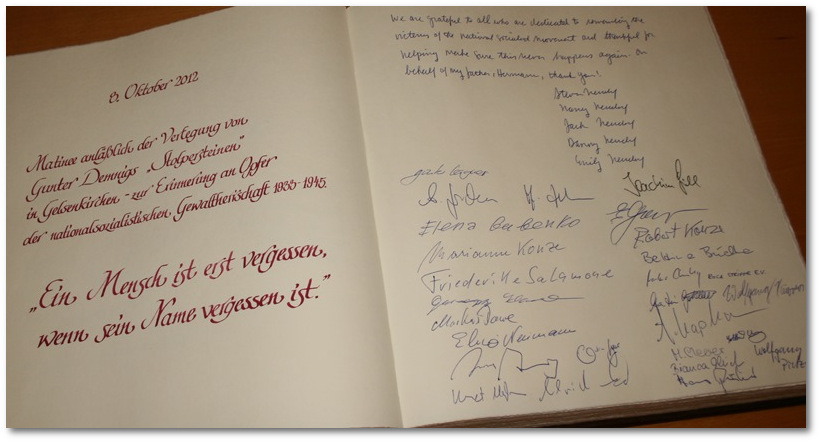
 Aus dem Leben von Herman D. Neudorf Aus dem Leben von Herman D. Neudorf
 The Memorys of Herman D. Neudorf - That was Riga The Memorys of Herman D. Neudorf - That was Riga
2009: Stones of remembrance (Stolpersteine) for Simon and Frieda Neudorf
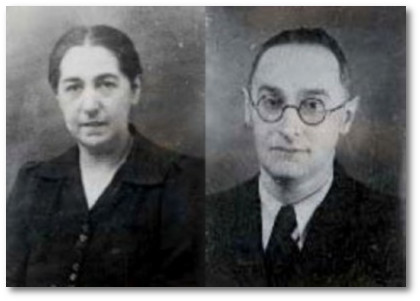
Frieda und Simon Neudorf
Simon Neudorf, originally coming from Lodz in Poland, was born on 7th February, 1899. His wife Frieda Neudorf, née Grünewald was born in Herford on 20th April, 1894. When German troops invaded Poland, Simon Neudorf was caught and dispaced to the concentration camp of Sachsenhausen where he was murdered on 14th of March, 1941. The urn with his mortal remains was sent to the family for a fee. The burial of the urn took place on the jewish cemetery in Gelsenkirchen-Ückendorf on 16th of April, 1941.
|
|
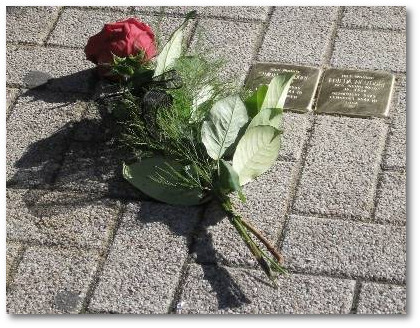
„ I regard these memorial stones as a
symbol of redemption“
Herman D. Neudorf, USA
Due to the signs of age, Herman Neudorf could not be present on the occasion of the installation of the Stolpersteine for his parents. Following his wish, Andreas Jordan represented him and called out his thoughts and words that he had put down in writing, when the stones were installed in Markenstrasse 19. Lothar Lange read the text in English. The jewish cantor Yuriy Zemskyi prayed the „El Male Rachamim“ for the victims of the holocaust.
|
Ladies and Gentlemen, dear friends,
I thank you all for coming in order to honour my beloved parents Simon and Frieda Neudorf. My precious father was murdered in the concentration camp of Sachsenhausen. He left Poland as a young man, in order to find a better future in Germany. He loved his „Horst-Emscher“ with all his heart. My beloved mother came from the city of Herford. Her maiden name was Grünewald – a popular family name for generations in Northrhine-Westphalia. Her brother Sigfried Grünewald joined the German army in 1914 as a volunteer and was killed in action in Russia. Frieda was shot in Riga in 1944. May these stones be signs of honour and a memory of two lovable and good persons, but also a warning that there is no place for racial fanaticism and intolerance any more. I will keep this day and moment as a sign of reconciliation in my heart.
Dear Andreas: I am fully aware that without your help this day would never have happened, and I want to thank you with all my heart. I also want to thank the community of Gelsenkirchen for their support and approval. I would have liked to come in person, but age and distance made this journey impossible.
I wish you all the best,
Herman Neudorf
Ladies & Gentlemen, dear friends,
How can I adequately describe to you my deep appreciation for what you and your community have accomplished by honoring my beloved parents Frieda and Simon Neudorf, the untimely victims of NAZI-persecution. My Vater loved his adopted Germany with all his heart. Escaping in his youth from his native Poland who denied him any opportunity for advancement in life,he found Germany friendly and wide open to his resourceful spirit.
My mother Frieda, a kind soul, born in Herford, nee Grünewald, a name in Westfalia known for Generations and whose brother Siegfried Grünewald volunteered for the Kaiser in 1914 and was killed on the Russian front. May this notable deed of placing these STOLPERSTEINE in their memory today serve as a remainder for Generations to come to be constantly aware of what blind prejudice can lead to. I consider these Stones as emblems of redemption!
My gratitude for my friend Andreas Jordan,the City of Gelsenkirchen, where I was born has no boundary. You must forgive me for not beeing able to be with you in person. Unfortunately, old age has its limitations. but Andreas Jordan will repesent me with all his heart.
With good wishes and greetings to all,
yours Herman Neudorf
Sehr geehrte Damen und Herren, liebe Freunde,
Wie kann ich meine tiefe Anerkennung für das, was Sie und ihre Stadt vollbringen, dadurch dass sie meine geliebten Eltern Frieda und Simon Neudorf, die frühen Opfer der Nazi-Verfolgung, ehren, angemessen ausdrücken? Mein Vater liebte sein angenommenes Deutschland von ganzem Herzen. Nachdem er als Jugendlicher seiner Heimat Polen entkommen war, wo ihm eine erfolgreiche Zukunft verwehrt wurde, fand er Deutschland freundlich und offen für seinen einfallsreichen Geist vor.
Meine liebe Mutter Frieda war eine geborene Grünwald, ein Name, der in Westfalen seit Generationen bekannt war. Ihr Bruder Siegfried Grünewald kämpfte freiwillig für den Kaiser und starb 1914 an der russischen Front. Möge dieser denkwürdige Akt der Stolpersteinlegung in ihrem Gedenken als Mahnung an kommende Generationen dienen, sich ständig dessen bewusst zu sein, wozu blinde Vorurteile führen können. Ich betrachte diese Steine als Symbole der Wiedergutmachung.
Meine Dankbarkeit gegenüber meinem Freund Andreas Jordan und der Stadt Gelsenkirchen ist grenzenlos. Sie müssen verzeihen, dass es mir nicht möglich ist, persönlich anwesend zu sein. Unglücklicherweise hat das Alter seine Einschränkungen, aber Andreas Jordan wird mich mit ganzem Herzen vertreten.
Mit guten Wünschen und Grüßen an alle,
Hochachtungsvoll,
Herman Neudorf
→ Photo album laying STOLPERSTEINE for Simon and Frieda Neudorf at Markenstrasse 19 in 2009
|
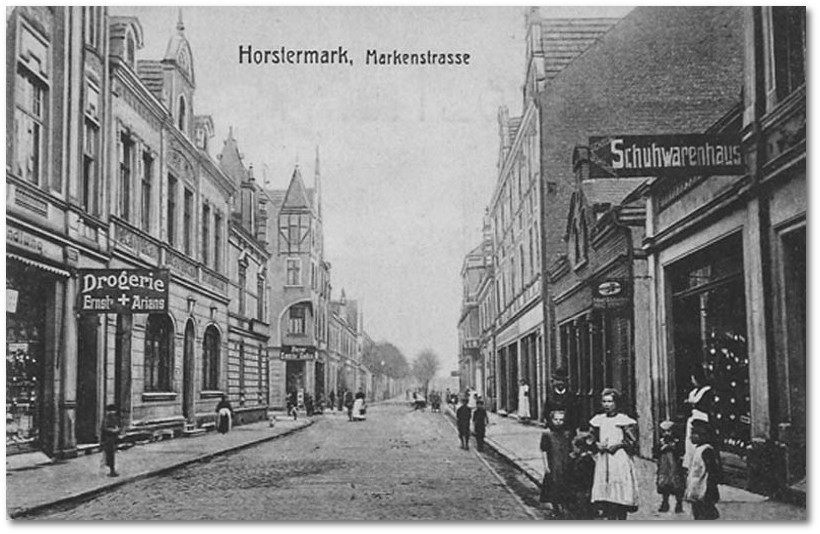
Fig.1: Markenstrasse in Horst-Emscher, around 1910 in the direction of Industriestrasse (today:
Schloßstrasse). In Nazi times there were two so-called „Judenhäuser“ in Markenstrasse
No 28 and 29
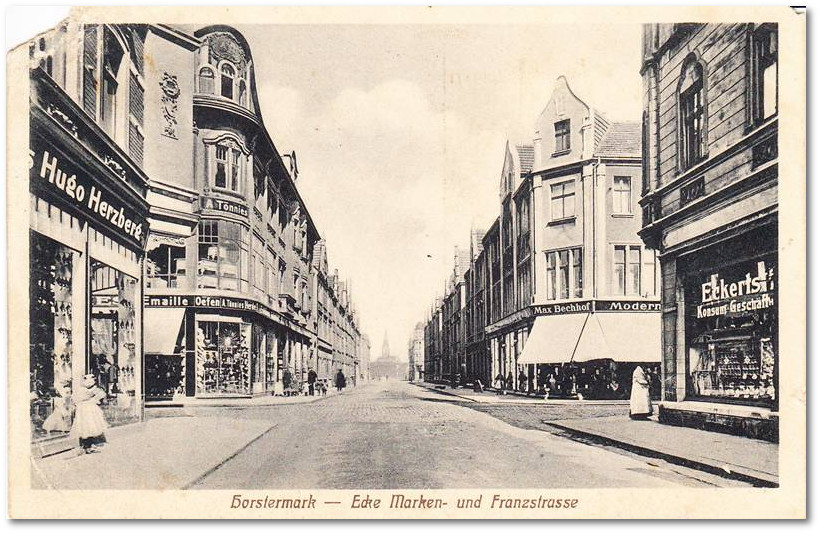
Fig.2: Franzstrasse, corner Markenstrasse in Horst-Emscher, around 1915
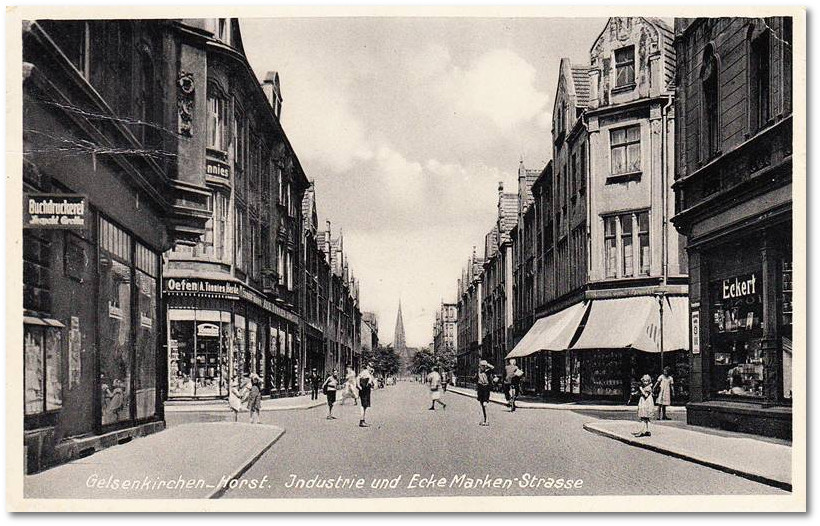
Fig.3 Industriestrasse, corner Markenstrasse in Gelsenkirchen-Horst, around 1936. The shoe shop of the jewish shopkeeper Hugo Herzberg has already been „arianized“. The former shop of the jewish shopkeeper Max Bechhoff is now called Specht and
is a grocery store. In the second half of the thirties, the family of Simon Neudorf lives
on the second floor.
Fig. 1-3 Collection Volker Bruckmann
|
Andreas Jordan, Projektgruppe STOLPERSTEINE Gelsenkirchen. März 2009. Nachtrag Oktober 2012.
Translation Stolpersteine Gelsenkirchen Familie Neudorf: Claudia Thul 02.07.2018
|